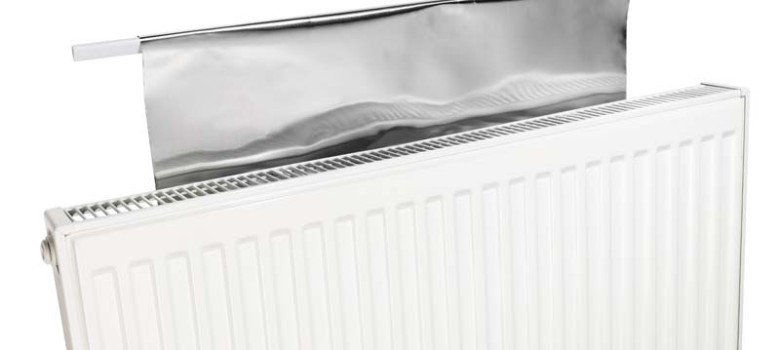
Radiator reflectors work on a very simple principle. You radiator radiates heat both into the room, and into the wall behind it. That heat can simply be lost to the outside, especially if you have thin single skin walls. Reflectors are installed behind the radiator and help prevent that heat from being lost by reflecting the heat back into the room.
Why shouldn’t you use foil for radiator reflectors?
There are a couple of reasons to use an approved material like Radflek. This approved material does not crinkle and crease like standard kitchen foil – it stays shiny and flat, in the ideal position to reflect heat. Foil can also oxidise over time as it is exposed to the environment, and this reduces its reflective properties, whereas radiator reflectors are treated with a chemical to prevent oxidisation. Putting kitchen foil behind the radiator is a false economy, as its effectiveness will be severely limited by these effects over time.
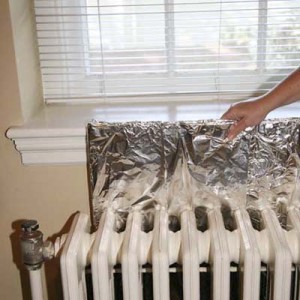
Homemade foil radiator reflectors crinkle easily and oxidise, losing their reflective qualities.
Which radiators work with radiator reflectors?
The walls where Radflek will make the most difference is in exposed areas of the property where the radiator is situated on an exterior wall. Internal walls are not heat loss walls, and therefore you won’t save any heat by installing reflectors there. Party walls between properties normally don’t need reflectors either, unless your next door neighbours don’t heat the house, or there is no one living there!
The type of radiator itself is usually unimportant, as reflectors will work with almost any radiator, as long as there is a space to fit the reflector in behind it.
How much difference do radiator reflectors make?
There was a BRE report considering Radflek radiator reflectors recently. The breakdown is very interesting:
| Type of Property | Savings per radiator / yr (0.6sqm) | Payback (Years) |
| Insulated Cavity Walls | £0.80 | 3.7 |
| Post 1983 Cavity Walls | £1.32 | 2.3 |
| 1976-82 Cavity Walls | £1.91 | 1.6 |
| Pre 1976 Cavity Walls | £2.75 | 1.1 |
| Uninsulated Solid Walls | £4.02 | 0.7 |
These figures are taken from an independent body’s research and we can see that the savings although small, stack up very well when you consider the low cost of the Radflek. In fact, I would go as far as saying that it makes sense for pretty much anyone to install Radflek, even those with well insulated cavity walls – the installation is so easy and the payback reasonably good, so there is no reason not to.
It really does pay to have radiator reflectors!
If you have 5 radiators on exposed walls in your property, you could be looking at savings of about £20 a year, that is payback in under 2 years. Even in a well insulated property, you would save around £5 a year paying back in 6-8 years.
With many other efficiency measures, you could be put off by looks, difficulty to install, or upfront cost. Radflek costs just £21.99 for a 3 radiator pack, is a simple DIY installation, and isn’t noticeable once installed correctly. Even better, GreenAge readers can get an exclusive 20% discount using offer code TGA20.
Think we missed something? Do you have a different opinion?
Comment below to get your voice heard…
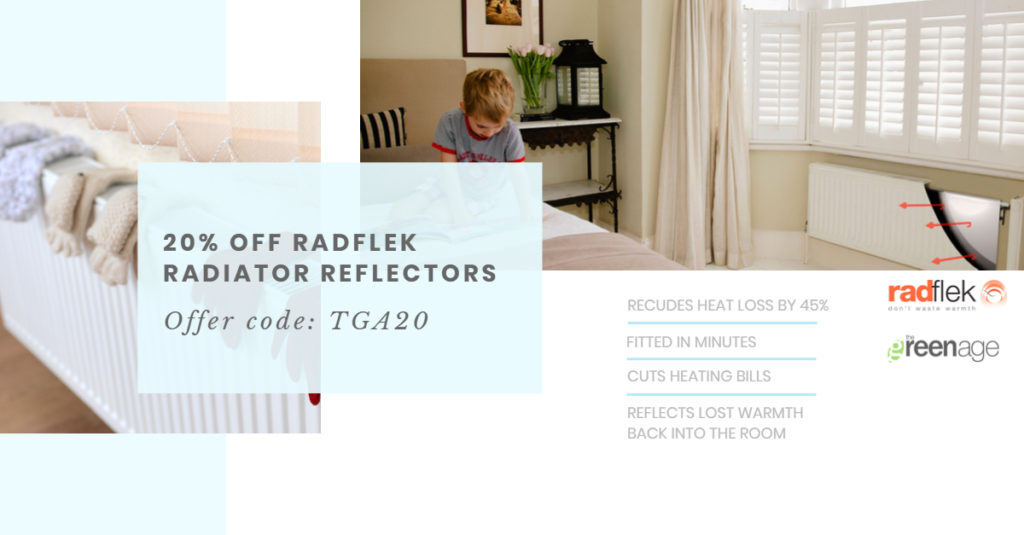




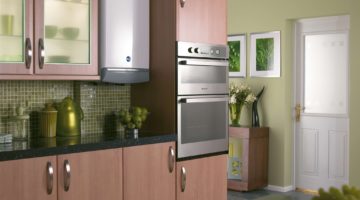
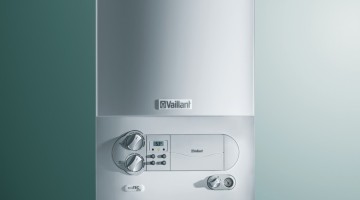






I tried to use Redflek and YES I can confirm that Redflex does work as advertised but I was put off by its looks so when I moved into my new house I immediately removed the plasterboard from behind all my radiator that are on a outside wall, which are 5 and then I improved the insulation to make sure there would be little or no loss of heat through the outside walls. I have since replaced all my radiator with column radiators and I now have a house that loses less heat through my outside walls, the heat in my radiator stays warm longer and my gas condensing boiler comes on very seldom. Finally I invested in a Heat Genius Smart Intelligent Heating Control that are already saving me over £400 annually in gas heating cost.
I went to a tradeshow in the excel centre and actually came across the radflek stand. The guy there seemed very knowledgable although I guess he was a salesman, anyway apparantly the difference between radflek and other radiator reflectors is the fact that they don’t oxidise over time becuase of the way they are constructed. This theory is therefore that these will keep reflecting the heat back into the room a lot longer than any DIY radiator reflector. I bought them for 6 rads and although I have only just turned the heating on they do seem to warm up the room a bit quicker. Not sure what the payback is like and I guess it is incredibly hard to acurately calculate but with energy bills going up I guess we should all be trying every option!
Hi Chris,
Radflek is indeed a great little product. We have seen studies by BRE that show a payback period of about 3-4 years for an old solid brick house, which is pretty impressive really for a simple little product like this that needs no maintenance. The Difference between Radflek and other radiator reflectors is that it coated to ensure it doesn’t oxidise over time so it maintains its reflective ability.
This is idiotic. The only result of aluminium oxidizing is aluminium oxide – which is an incredibly tough material that prevents corrosion.
Therefore all aluminium is fine to use as it cannot corrode. There is a difference between oxidizing and corroding.
Hi Oxy, we talk about oxidation here – not corrosion. Shinny materials do reflect heat better than matt materials – which is one of the reasons radflek works so well.
I have panel heaters. Do reflectors work with them?
Do the panel heaters have fans on them? If so, then no – as the heat is blown out by the fan to help heat the room more effectively! If there is no fan and heat is also coming out the back of the unit, then these reflectors would certainly help!
“…approved material does not crinkle and crease like standard kitchen foil – it stays shiny and flat, in the ideal position to reflect heat. Foil can also oxidise over time as it is exposed to the environment..”
Aluminium reflects away from the wall whether crinkled or flat and aluminium oxidises on exposure to ordinary moist air within milliseconds.(which is why it is so difficult to solder to aluminium)
However a build up of dust will suppress its reflectivity as indeed it will on the product (Radflek) you are trying to sell. I recommend gluing kitchen foil to an insulating backing and clipping this so it may be removed occasionally for cleaning.
Hi, I hope u are all well. I love to make recycled things especially out of foam facia. I made some really effective radiator covers using 10cm boards with a 5cm overlapping gap. My ma-in-law said she wasn’t getting any heat from her radiator with the cover on. I couldn’t understand why as ours is fine, my cover heats up and holds the heat for quite a while. But (big but maybe) when I removed her cover I realised I had lined the panels with aluminium or foil tape. So now I’m thinking that the tape has been working as a reflector instead of an insulator, could this have been the problem all along. Any advice would be greatly appreciated
Although kitchen foil would lose effectiveness over time, doesn’t the cost saving make it work it? For £15 you could you use and replace the foil at least 50 times over!
Hi, I am interested in installing radflek / another radiator refelctor, but just wondering how long they last behind the radiator. Not going to lie I am unlikely to clean them once they are installed. Does dust reduce their lifespan / their effectiveness? Any thoughts would be welcomed!
Hi Anne,
Radflek is certified by the BBA (British Board of Agrément) to have a life of at least 60 years. You would need to do an occasional dusting to keep them working at their best, but all that’s required is to lift them out and give them a once over with a damp cloth.
Many thanks,
Harriet
Can these be attached to the wall easily and without removing the radiators?
Why do the instructions tell you to face the shiny side facing the wall and the matt low reflective side facing the radiator? This contradicts all advice. Thanks.
As it says in the FAQs on the radflek.com website, “Although the shiny side reflects light better the matt side reflects heat more effectively.”
do the radiator reflectors work with storage heaters?
Annoyingly I have a socket halfway behind the radiator that the pipes for the radiator go into, would I still be able to fit Radflek panels?
If you find the adhesive fails to hold the sheet in place in the long term can I recommend using wine corks; just the right size and elasticity. They are quite expensive as only better wine uses them these days, but they are 100% sustainable and more fun than than other options.
Hi could I use these to help keep the heat in ,on the back of my fish tank? Especially in a power cut. Would these help? Thank you